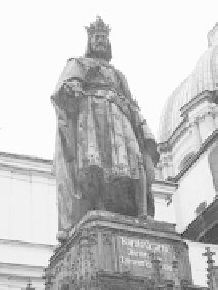Travel Reference
In-Depth Information
charles Bridge reconstruction
Talked about for many years, financed by the city of Prague,
and scheduled to last over a decade, the long-overdue recon-
struction of the Charles Bridge finally began in the summer
of 2007, days after the city celebrated the bridge's 650-year
anniversary.
Aware of the blow that closing the entire bridge would
deal to the tourist industry, the city chose a more costly and
technologically challenging “chessboard” strategy. With
this plan, only a small section is closed at any time, allowing
people to continue using the bridge, but leading to midday
crowds in the resulting bottleneck. To give everyone the
opportunity to peek inside the centuries-old structure, and
thus turn the bridge renovation into Prague's new attraction,
the mayor requested (to the dismay of many archaeologists)
that the construction site be at all times surrounded only by
light, transparent fences.
The reconstruction is being carried out in two stages. In
the first major stage—preceded by archaeological excava-
tions and scheduled to be completed by 2010—gas lighting
will return to the bridge, and the sewage system, insulation,
and pavement will be installed. In the next stage, many of the
deteriorated sandstone pieces will be replaced by new ones.
In the past, builders often chose poor-quality sandstone, and
this is precisely the mistake current workers want to avoid.
To minimize impact on the nearby areas, most of the building
materials will be transported by river.
bridge's namesake,
C h a r l e s I V.
This Holy Roman Emperor (Karlo
Quatro—the guy on the 100-Kč bill)
ruled his vast empire from Prague in
the 14th century. He's holding a con-
tract establishing Prague's university
(see sidebar on page 64), the first in
Northern Europe. This statue was
erected in 1848 to celebrate the uni-
versity's 500th birthday. The women
around Charles' pedestal symbolize
the university's four subjects: the arts,
medicine, law, and theology. (From
the corner by the busy street, many think the emperor's silhouette
makes it appear as if he's peeing on the tourists. Which reminds
me, public WCs are in the passageway opposite the statue.)
Bridges had been built on this spot before, as the remnant
tower from Judith Bridge testifies (see the smaller of the two bridge
towers at the far end). All were washed away by floods. After a




















